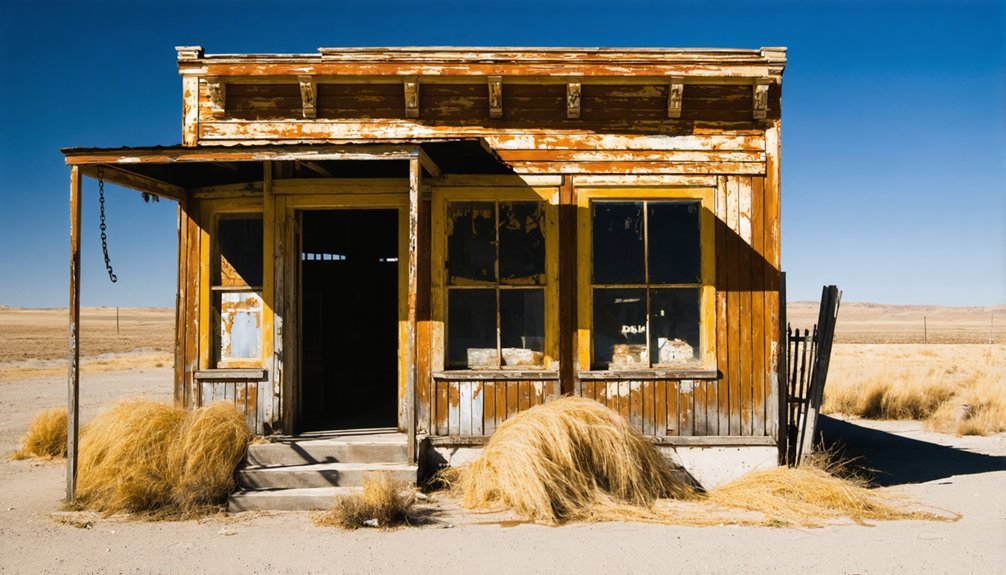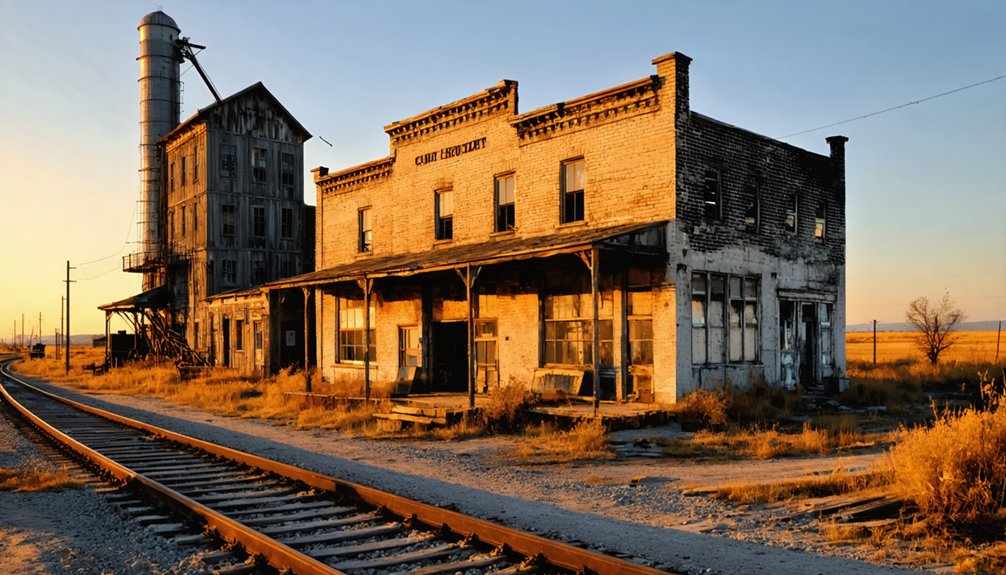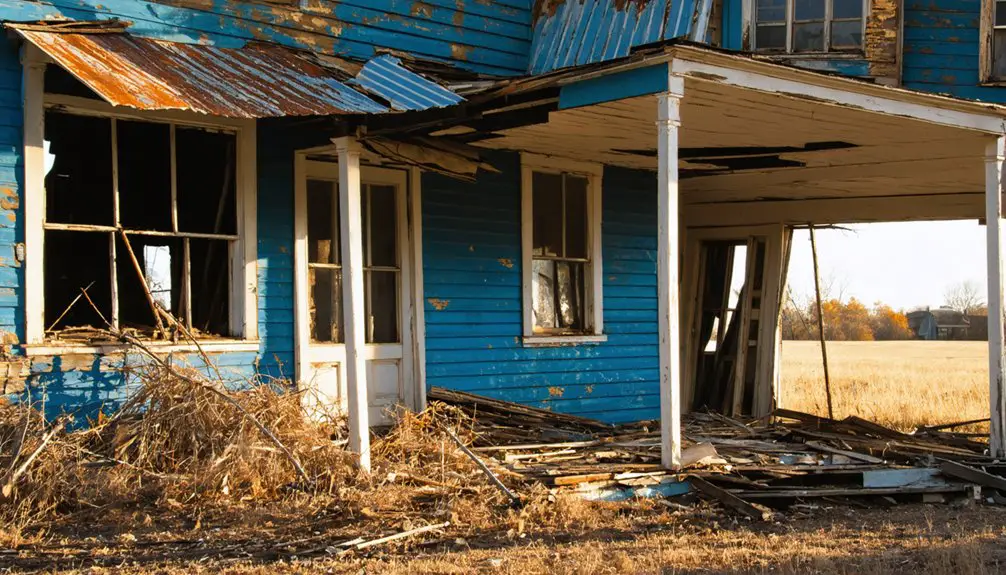You’ll find Santa Fe’s ghost town story in Haskell County, Kansas, where a bustling frontier settlement emerged in 1885. The town quickly grew to 2,000 residents, boasting three banks, five newspapers, and two churches during its peak in 1888. When major railroads bypassed Santa Fe for nearby Sublette, the town’s fortunes declined. After losing its county seat status in 1913, Santa Fe rapidly emptied, and by 1926, this once-promising community had completely vanished. The town’s dramatic rise and fall reveals deeper truths about frontier settlement dreams.
Key Takeaways
- Santa Fe, Kansas became a ghost town by 1926 after losing its county seat status to Sublette in 1913.
- Originally founded in 1885, the town peaked in 1888 with up to 18,000 residents before severe droughts caused mass exodus.
- The town’s decline accelerated when major railroad lines bypassed Santa Fe in favor of nearby Sublette.
- During its peak, Santa Fe boasted three banks, five newspapers, two churches, lumber yards, and a flour mill.
- No physical structures remain today, though Santa Fe’s brief existence exemplifies the boom-and-bust cycle of frontier settlements.
The Birth of a Kansas Frontier Town
While the American frontier continued its westward expansion in the 1880s, a new settlement emerged in southwestern Kansas. You’d find the town’s founding as Star City on June 4, 1885, though it quickly transformed into Santa Fe, drawing its name from the historic Santa Fe Trail just five miles north.
The town’s strategic location sparked rapid commerce growth, leading to its official platting in June 1886. To avoid confusion with other similarly named locations, early documents often included references to Santa Fe, Kansas specifically.
When Haskell County formed in March 1887, Santa Fe became its beating heart. You’ll recognize the town’s rising importance as it secured the county seat position by November 1887. The community’s formal status was elevated when it became incorporated as a third-class city in early 1888.
Within its first years, you’d discover a bustling frontier community complete with grocery stores, hotels, banks, newspapers, and churches – all the hallmarks of a promising western settlement.
Peak Years and Population Boom
During Santa Fe’s peak in 1888, you’d find three banks, five newspapers, a school, two churches, and various businesses serving a population that sources estimate between 600 and 18,000 residents.
Similar to Bell Plane settlers, early residents paid $1.25 per acre to purchase their land and establish themselves in the area.
You could travel to Santa Fe only by Lee and Reynolds stagecoach line, as the much-anticipated railroad hadn’t yet arrived in town.
With Santa Fe’s designation as county seat in late 1887, you’d see the town buzzing with civic activity, though the exact population remains debated due to rapid transient growth during the boom years.
Like many Kansas towns of that era, Santa Fe’s future hinged on whether the railroad construction would reach the town, as this was often the deciding factor between growth and abandonment.
Population Numbers and Estimates
Santa Fe reached its peak population in January 1888, though historical estimates vary dramatically from 600-700 residents to as high as 18,000. These demographic fluctuations make it challenging to pinpoint exact numbers, partly due to census challenges and rapid growth during the town’s early development.
When Santa Fe incorporated as a third-class city, you’d have found between 350 and 2,000 residents there. The town’s liveliness was evident in its three banks, five newspapers, two churches, and numerous businesses. Much like the Diamond Springs post office, Santa Fe’s local government services played a crucial role in establishing the town’s legitimacy.
As the county seat, Santa Fe attracted government officials and entrepreneurs, helping sustain its population through the late 1880s. However, you’d have witnessed a steady decline within a few years after the peak, especially when the railroad bypassed the town, leading to its eventual transformation into a ghost town.
Growth During Railroad Dreams
The promise of railroad connections fueled Santa Fe’s dramatic growth during its peak years in the late 1880s. You’d have found a bustling community enthusiastically raising over $10,000 to attract railway companies, with both the Kansas, Texas & Southwestern Railroad and Dodge City, Montezuma & Trinidad Railroad showing interest in the town.
During this period of railroad aspirations, Santa Fe’s economic prospects seemed boundless. Similar to the overinvestment in infrastructure that caused widespread railroad financial troubles in the 1880s, many local communities bet heavily on rail development. The 1890s saw the community organizing regular social events and maintaining active businesses, all while promoting itself as an ideal railway destination. Like the Leavenworth, Lawrence & Galveston railroad before them, many railway companies of the era faced financial difficulties that affected their expansion plans.
The town’s agricultural foundation remained strong, but locals knew rail access would transform their community into an essential commercial hub. Despite their determined fundraising efforts and promotional activities, the major rail lines ultimately bypassed Santa Fe, choosing nearby Sublette instead.
Early Business and Services
Anyone visiting Santa Fe, Kansas in 1888 would’ve found a thriving town of up to 18,000 residents, complete with nearly 10 saloons, multiple general stores, and crucial professional services.
As the newly designated county seat, you’d have encountered a bustling hub of commercial diversity, from hotels and bars to blacksmith shops and a post office. Much like in Columbia, Kansas, the town had a log store and blacksmith to serve early settlers. The town’s civic engagement was evident through regular community events and a functioning local government, officially incorporated on January 2, 1888.
You’d have found doctors and judges serving the growing population, while law enforcement maintained order, as demonstrated during the notable 1884 Honeywell gunfight.
The community’s economic significance showed in their swift raising of $10,000 to attract railroad investment, though this prosperity wouldn’t last through the challenging drought years ahead.
Railroad Dreams and Broken Promises
During the late 1870s, fierce railroad competition shaped Kansas’s development as the Santa Fe Railway aggressively expanded its network through strategic acquisitions and public subsidies.
As the railroad sought to outmaneuver rivals like the Kansas City, Burlington and Southwestern Railway, it made sweeping railroad promises to secure local support and funding.
Railroads made grand promises to towns along proposed routes, vying for local backing in their heated quest for territorial dominance.
The Royal Gorge War with Denver & Rio Grande Railway demonstrated Santa Fe’s aggressive expansion tactics during this period.
You’ll find that many towns placed their hopes in Santa Fe’s pledges of direct rail service, investing their futures in these town expectations.
However, the railway often prioritized profitable routes over promised ones, bypassing communities when geographic challenges or strategic decisions dictated.
While some bypassed towns later received branch line connections, others weren’t so fortunate.
The harsh reality of broken promises left certain communities economically marginalized, their dreams of prosperity fading as the main line passed them by.
Towns like Wichita secured their railway future by offering $200,000 in bonds to attract railroad development.
Environmental Challenges and Economic Hardships

Despite initial optimism in Santa Fe’s agricultural prospects, devastating droughts in the late 1880s marked the beginning of the town’s environmental and economic decline.
You’d find that conditions briefly improved in the early 1890s, but the region’s lack of drought resilience strategies left farmers vulnerable when even harsher conditions struck later that decade, forcing 40-60% of residents to abandon their land.
The town’s limited economic diversification efforts couldn’t overcome the perfect storm of challenges.
Soil degradation and repeated crop failures diminished land values, while advancing farm mechanization reduced local employment.
Without proper irrigation infrastructure or environmental restoration programs, the productive capacity of the land continued to deteriorate.
The combined effects of these environmental pressures and agricultural consolidation ultimately sealed Santa Fe’s fate.
The Loss of County Seat Status
Santa Fe’s grip on its county seat status began to unravel in early 1913, when Sublette challenged the town’s position through a contentious referendum.
While Sublette initially failed to secure the required three-fifths vote, their attorneys took the fight to the Kansas State Supreme Court, which overturned the requirement and awarded them the county seat on June 7, 1913.
Despite falling short of the required supermajority, Sublette won the county seat through legal action in Kansas’s highest court.
The loss triggered a dramatic population decline in Santa Fe, marked by:
- Residents migrating to Sublette and other towns
- Physical relocation of houses and buildings to Sublette
- Closure of the Santa Fe Monitor newspaper by 1918
- Official abandonment declaration by 1926
The railroad’s presence in Sublette proved decisive, as it offered better transportation and economic opportunities that Santa Fe couldn’t match.
From Bustling Community to Abandonment

When entrepreneurs first platted Santa Fe in July 1886, they couldn’t have imagined its rapid rise and fall. Within just two years, you’d have found a vibrant community with three banks, multiple churches, a flour mill, and five competing newspapers.
The town’s community dynamics reflected an ambitious spirit, as businesses rapidly established themselves to serve a growing population.
Despite early promise, Santa Fe’s economic shifts proved challenging. Without railroad access, you’d have faced significant limitations relying solely on stagecoach transportation.
The town’s isolation from major transport routes ultimately undermined its sustainability. While population estimates varied dramatically from 600 to 18,000 at its peak, the decline came swiftly.
Historical Legacy and Present-Day Remnants
Though its physical structures have largely vanished, Santa Fe’s historical legacy endures through its role as Haskell County’s first county seat from 1887 to 1913.
Despite the absence of buildings today, Santa Fe’s impact lives on as the pioneering seat of Haskell County government.
You’ll find Santa Fe’s civic significance rooted in its strategic location near the Santa Fe Trail, a crucial artery among regional trade routes that initially promised prosperity for the community.
The town’s vibrant past included:
- Three thriving banks and multiple businesses including lumber yards and a flour mill
- Multiple newspapers documenting local life from 1888 to 1918
- A formal incorporation as a third-class city in 1888
- A complex relationship with transportation, relying on stagecoach lines without railroad access
Today, while physical remnants are scarce, Santa Fe’s story serves as a reflection of the dynamic nature of frontier settlements in Kansas’s developmental years.
Frequently Asked Questions
Are There Any Known Photographs of Santa Fe, Kansas During Its Peak Years?
You won’t find any confirmed historical photographs from Santa Fe’s peak years. While there’s mention of a “handsome picture” donated to a lodge, no verified images of the town survive.
What Happened to the Buildings and Materials From the Abandoned Town?
You’ll find that nearly 90% of buildings were dismantled for material repurposing, with locals salvaging lumber and stone for their farms. Weather and tornadoes destroyed what wasn’t preserved, leaving scattered ruins.
Did Any Notable Historical Figures Ever Visit Santa Fe, Kansas?
While you’d find historical visits by traders and pioneers along the nearby Santa Fe Trail, there’s no documented evidence of notable figures specifically visiting Santa Fe, Kansas during its brief existence.
Were There Any Major Crimes or Significant Lawlessness in Santa Fe?
You’d be surprised, but there’s no documented evidence of major crimes or high crime rates in this frontier town. While law enforcement existed during its county seat years, historical records show remarkably peaceful conditions.
What Native American Tribes Lived in the Area Before Santa Fe’s Establishment?
You’ll find that Kansa and Osage Native tribes originally dominated this region, holding cultural significance through their settlements along the Kansas Valley before being pushed out by other Plains tribes.
References
- https://www.youtube.com/watch?v=W1-_bKMRNIg
- https://en.wikipedia.org/wiki/Santa_Fe
- https://digging-history.com/2015/02/18/ghost-town-wednesday-santa-fe-kansas/
- https://www.legendsofamerica.com/diamond-springs-kansas/
- https://legendsofkansas.com/lost-spring-stationkansas/
- https://esirc.emporia.edu/bitstream/handle/123456789/1313/Richards Vol 5 Num 1.pdf?sequence=4
- https://www.nps.gov/safe/learn/historyculture/index.htm
- https://www.legendsofamerica.com/ks-santafetrailjoco/
- https://www.hhhistory.com/2019/05/ghost-towns-of-kansas.html
- https://www.youtube.com/watch?v=OyBXD18P_j4



